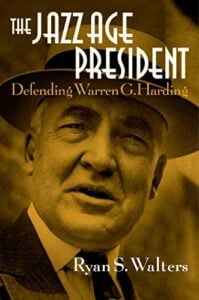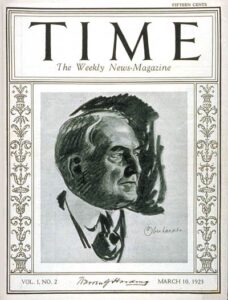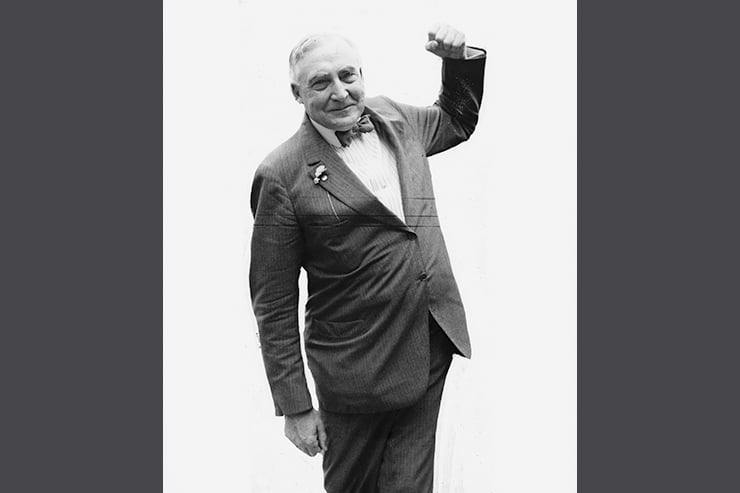
The Jazz Age President: Defending Warren G. Harding
by Ryan S. Walters
Regnery
320 pp., $29.99
It has become a herd-instinct ritual. A survey asks “leading” historians and political scientists to rank America’s presidents from best to worst. The results, with variations here and there, are predictable. In the top tier are Founding Fathers and game-changers: Washington, Jefferson, Madison, Lincoln, and both Roosevelts. Heavily represented in the second tier are quasi-transformative, post-World War II liberals Truman, Kennedy, Clinton, and Obama, plus, in a bow to bipartisanship, Eisenhower and Reagan. Ranking at the bottom are “do nothing” misfits and reactionaries on the order of Fillmore, Buchanan, Harding, Nixon, and Trump.
Warren Harding, though frequently grouped among “the worst presidents ever,” deserves far better. Thankfully, help is on the way, in the form of a new contrarian biography, The Jazz Age President: Defending Warren G. Harding. Author Ryan Walters, an independent-minded historian, knows well the long-standing disdain for Harding among people who should know better. Setting the record straight is why he wrote the book.
According to keepers of the official tablets, Warren Harding, our 29th president, was an inept, bumbling cipher with little grasp of the issues. He was oblivious to corruption and likely a beneficiary of it. He was a shameless philanderer. He “lacked vision” (i.e., had no desire to build on the centralizing agenda of his predecessor, Woodrow Wilson). To top it off, he had a naïve faith in markets, which led to the Great Depression.
A prominent peddler of this narrative, Nathan Miller, author of Star-Spangled Men: America’s Ten Worst Presidents, describes Harding as “a prime example of incompetence, sloth, and feeble good nature in the White House.” Such critics seem to view Harding’s death in office, in August 1923, as a blessing.
Walters isn’t having any of this. Analyzing eight common charges against Harding, the author concludes that none holds up. Far from leading America into crisis, Harding led the country out of it, a feat no reprobate boob could have managed.
Harding began his road to the White House as a journalist and entrepreneur, having bought a local newspaper in his 20s. The experience helped him develop political skills and connections, and he eventually became Ohio governor and then a U.S. senator. As president, he amounted to something far more substantial than the clueless stumblebum of his critics’ imagination.
The 1920 election was, in effect, a mandate against the Wilson presidency. H. L. Mencken, no Harding admirer, wrote regarding Wilson that “[Americans] are weary of hearing highfalutin and meaningless words; they sicken of an idealism that is oblique, confusing, dishonest and ferocious.” The election result wasn’t even close. Harding routed Democrat and fellow Ohioan James Cox by 60 percent to 34 percent in the popular vote and 404 to 127 in the Electoral College.

of the March 10, 1923, issue
of Time. (public domain)
When President Harding took his oath of office on March 4, 1921, he inherited a full plate of problems. His campaign promise of “a return to normalcy” meant that he would have to grapple with national disintegration. The year 1919 had brought forth a wave of strikes, race riots, and anarchist bombings. Terrorism continued into 1920, climaxing that Sept. 16 with an explosion in Manhattan’s Financial District that killed nearly 40 people and injured hundreds more. In addition, an economic depression was underway, with high unemployment and severe monetary deflation.
Harding went about addressing these and other challenges with deliberation and decisiveness. In foreign affairs, he was a noninterventionist but not an isolationist. He cultivated cordial relations with other nations but with an insistence upon avoiding entanglements. “America can be a party to no permanent military alliance,” he declared in his inaugural address. “It can enter into no political commitments, nor assume any economic obligations which will subject our decisions to any other than our own authority.”
Among noteworthy international achievements, Harding put into effect a congressionally approved plan to enable cash-strapped Great Britain to repay its war debts, signed the Knox-Porter Resolution on July 2, 1921, ending our hostilities with Germany and Austria-Hungary, and organized the Washington Naval Conference, which produced an agreement between the U.S., Great Britain, France, Italy, and Japan to reduce the size of their battleship fleets.
On the domestic side, the charge that Harding’s economic program was a blueprint for ruin is contradicted by the evidence. His aggressive proposals for cuts in taxes and spending, once enacted, triggered a boom that continued six years beyond his death. Real per capita income rose by about 2 percent annually during the decade that began with his presidency. Unemployment sharply fell; at one point in 1926, it dipped to 1.6 percent. Gross domestic product during 1922-27 rose by about 6 percent a year. The national debt, which stood at $26 billion when Harding took office, was only $17 billion in 1929. And the Great Depression, brought on primarily by misguided monetary policies, was not Harding’s doing.
The most common accusation leveled against President Harding was that he was a bought politician, the maypole of a corrupt “Ohio gang.” Yet after examining the range of evidence, Walters finds this claim baseless. Yes, several administration officials during Harding’s tenure engaged in self-dealing. But there was no evidence that he was aware of the corruption while it happened, that he was apathetic toward it once revealed, or that he benefited from it himself.
The scandal at the new Veterans’ Bureau was the doing of its director, Charles Forbes, who received lucrative kickbacks on land purchases and hospital construction, and sold government medical supplies at a fraction of their value for personal gain. Far from winking at this graft, Harding virulently objected, even to the point of physically assaulting Forbes during a White House confrontation, grabbing him by the throat and shaking him. Forbes wound up getting a two-year prison sentence.
The corruption at the Justice Department centered around Jesse “Jess” Smith, the right-hand man of Attorney General Harry Daugherty. Smith routinely provided pardons, liquor licenses, judgeships, and other friendly favors in return for payola. Yet it was Daugherty, not President Harding, who had appointed Smith. And when Harding got wind of these bribes, he ordered Smith thrown out of Washington. Personally told by Harding of his impending arrest, Smith committed suicide the next day, though some have claimed that he was murdered by others involved in the corruption.
As for the infamous Teapot Dome scandal, it was not the stuff of failed presidencies either. It involved the transfer of a pair of large oil reserves, one in Wyoming and the other in California, originally set aside for use by the U.S. Navy. In 1921, Secretary of the Interior Albert Fall convinced Navy Secretary Edwin Denby to transfer control of the properties to his department. President Harding signed an executive order authorizing the transfer. Unbeknownst to him, Fall—at the time undergoing personal financial difficulties—cut a side deal with oilmen Harry Sinclair and Edward Doheny. Fall would lease the reserves to them, one to a customer, in return for $400,000 in bribes. For his crime, Fall served a year in jail.
“This idea that Harding knowingly appointed a bunch of crooks to office so they could loot the U.S. treasury is nothing more than a smear,” Walters concludes. To his detractors, Harding was guilty by association.
If Harding succeeded in his mission without personally bringing reproach upon himself or his office, why do political historians reflexively judge him so harshly? Maybe it’s because they don’t like the mission. Walters draws parallels with Donald Trump, who has already earned a secure place in the presidential ratings basement. The genial, introverted Harding and the rude, bombastic Trump were vastly different in temperament, but they shared similar views on trade, taxes, immigration, and foreign intervention. Moreover, they were both deeply patriotic.
Harding’s one false career move, it would seem, was dying in office. Had he lived to be reelected in 1924—that honor would go to his vice president and presidential successor Calvin Coolidge—he might have had enough validation to avoid the wrath of manufactured public opinion.
In justice, The Jazz Age President should induce a favorable shift in the overall perception of Warren Harding. It would be none too soon. Given our present cancel-culture habit of constructing false narratives about those who shaped our past, a reassessment has never been more needed.

Leave a Reply